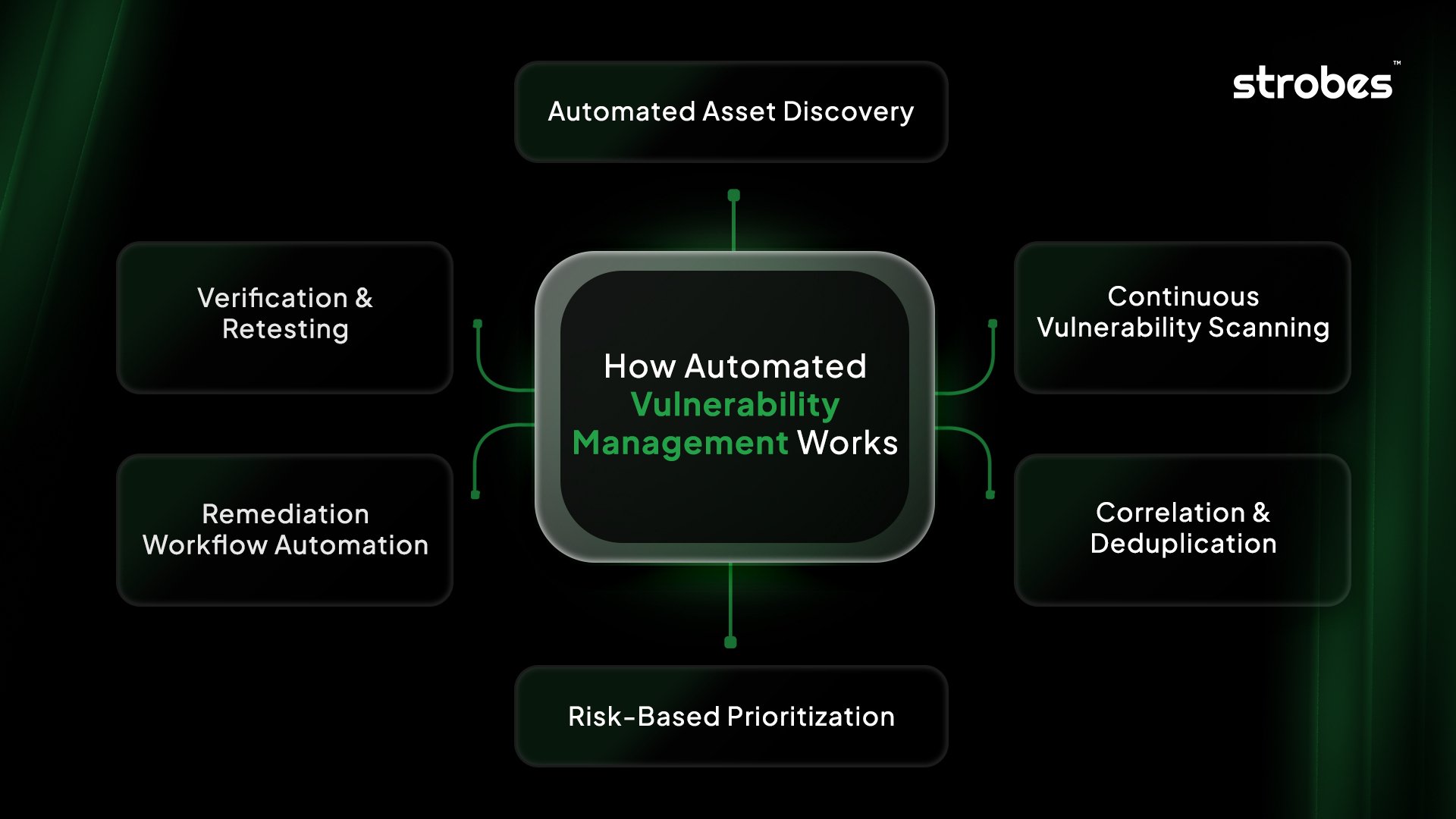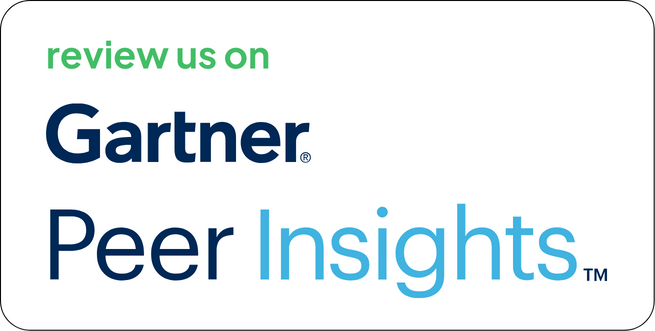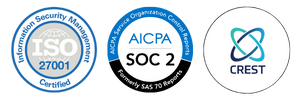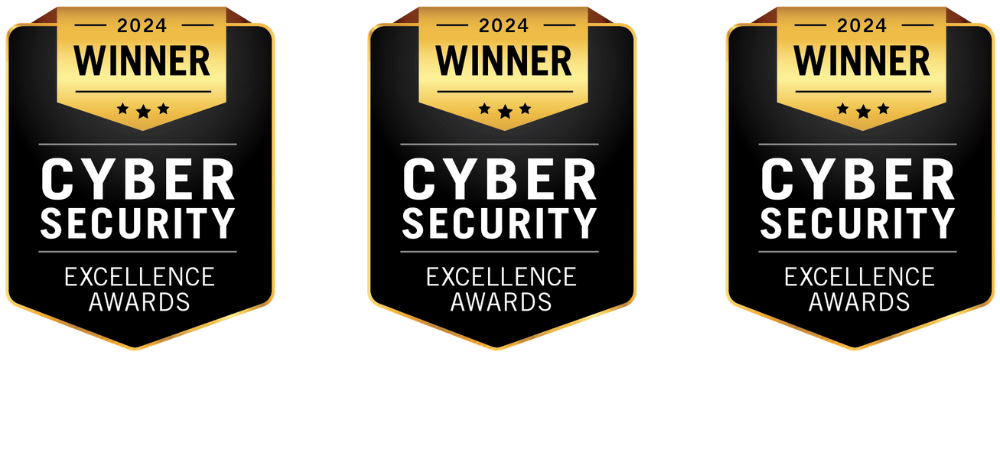Organizations nowadays are struggling with a growing IT environment, cloud-based workloads, APIs, IoT devices, and containerized applications are just a few of the ingredients thrown into the mix. With every new asset comes the potential to grow the attack surface area, along with the possibility of introducing vulnerabilities. In 2024 alone, more than 29,000 new CVEs were documented by the National Vulnerability Database (NVD), and that number increases year over year.
Legacy approaches to vulnerability tracking, like spreadsheets, manual scanning, and isolated remediation workflows, are unable to handle this volume. Security teams are typically swamped by the sheer volume of findings and cannot prioritize what’s most important.
This is where automated vulnerability management comes into play. Through the replacement of manual effort with automation, organizations can continually discover, scan, prioritize, and fix vulnerabilities at scale, with remediation efforts aligned to actual business risks.
In this blog, we’ll break down what automated vulnerability management is, how it works, why manual methods fall short, and the benefits and best practices of adopting this approach.
What Is Automated Vulnerability Management?
Automated vulnerability management is all about using automation tools and processes to keep a constant eye on, analyze, prioritize, and fix vulnerabilities within an organization’s IT infrastructure. Instead of relying on those occasional manual scans, automation enables ongoing monitoring and immediate responses.
Key Features of Automated Vulnerability Management
Automated Asset Discovery:
The foundation of any vulnerability management program is knowing exactly what assets exist in your environment. Manual inventory often misses unmanaged devices, shadow IT, or newly deployed cloud workloads. Automated asset discovery continuously scans networks, cloud accounts, containers, and endpoints to maintain a real-time inventory. This ensures that no device, application, or integration slips under the radar.
Continuous Scanning:
Instead of relying on one-off assessments, automated systems perform ongoing scans. They integrate with multiple scanners such as:
- SAST (Static Application Security Testing) for analyzing source code.
- DAST (Dynamic Application Security Testing) for evaluating live applications.
- SCA (Software Composition Analysis) for identifying risks in open-source components.
- Container and Kubernetes Security Scanning for detecting issues within containerized environments.
- Secret Scanning for spotting exposed credentials or API keys in repositories.
This continuous approach reduces exposure windows and detects vulnerabilities as soon as they appear.
Vulnerability Correlation & Deduplication:
When multiple scanners are running, results often overlap. Without correlation, security teams waste hours triaging duplicate findings. Automated correlation consolidates these results into a single, unified view and removes duplicates. This not only cuts down noise but also makes remediation workflows much more efficient.
Risk-Based Prioritization:
Not all vulnerabilities require the same urgency. Traditional approaches often rely only on CVSS scores, which don’t provide the full context. Automated prioritization combines:
- Exploit intelligence (whether attackers are actively exploiting it).
- Business context (how critical the affected asset is to operations).
- Severity scores (CVSS and beyond).
This ensures that security teams focus their time on vulnerabilities that could cause the most damage if left unresolved.
Workflow Automation:
One of the biggest challenges in vulnerability management is closing the gap between discovery and remediation. Automation solves this by pushing vulnerabilities directly into ITSM and DevOps tools such as Jira, ServiceNow, or GitHub. Tickets are automatically assigned to the right teams, with all necessary context included, eliminating delays caused by manual hand-offs.
Compliance Monitoring:
It generates automated reports to help with regulatory compliance and audits for standards like PCI-DSS, HIPAA, and ISO 27001. By automating these processes, security teams can save time, reduce human error, and ensure that remediation efforts align with the actual risk exposure.
How Automated Vulnerability Management Works?
The journey of automated vulnerability management usually unfolds in a series of connected stages:
1. Automated Asset Discovery
The very first step in this automation process is to gain complete visibility into every asset within the organization. This encompasses:
- On-premise servers and endpoints.
- Cloud resources like AWS, Azure, and GCP.
- APIs and SaaS applications.
- Containers and Kubernetes clusters.
Automated discovery tools continuously scan to ensure that no asset slips through the cracks. Skipping this step could leave organizations vulnerable to blind spots that attackers might exploit.
2. Continuous Vulnerability Scanning
Rather than sticking to quarterly or annual scans, automated solutions allow for continuous vulnerability scanning. This includes:
- SAST (Static Application Security Testing) – Scanning source code for vulnerabilities.
- DAST (Dynamic Application Security Testing) – Testing applications while they’re running.
- SCA (Software Composition Analysis) – Identifying vulnerabilities in open-source dependencies.
- Container Security Scanning – Spotting misconfigurations and vulnerabilities within container images.
- Secret Scanning – Finding hardcoded credentials and API keys in repositories.
This comprehensive approach ensures that vulnerabilities are detected across all layers of the IT stack.
3. Correlation & Deduplication
When multiple scanners are in play, results can often overlap. Automating helps to eliminate duplicate findings, consolidate results, and provide a single source of truth for security teams. This way, time isn’t wasted on addressing the same vulnerability repeatedly.
4. Risk-Based Prioritization
Automating vulnerability management isn’t just about the numbers; it’s about what matters most. Tools leverage contextual data such as:
- CVSS Scores – A standardized severity rating.
- Exploit Intelligence – Whether the vulnerability is currently being exploited in the wild.
- Business Context – Whether the affected asset is crucial for key business functions.
5. Remediation Workflow Automation
Prioritized vulnerabilities are automatically pushed into remediation platforms. Some examples include:
- Creating Jira or ServiceNow tickets.
- Sending Slack or Microsoft Teams alerts.
- Integration with CI/CD pipelines to prevent vulnerable code from being deployed.
This allows for quicker response and responsibility without the need for intervention.
6. Verification & Retesting
After remediation, automated retesting validates whether vulnerabilities have been successfully fixed or not. It closes the loop and eliminates repeat issues.
Why Manual Vulnerability Management Is Inadequate?
Companies that use manual processes are hindered by the following:
Volume and Scale
Thousands of results can be returned from a single vulnerability scan. Manually sorting and prioritizing them can be an exercise that lasts weeks, with critical vulnerabilities open in the meantime.
Human Error
Manual triage commonly brings about inconsistencies. Various team members can have differing priorities for vulnerabilities, causing delays or overlooked risks.
Lack of Continuous Monitoring
Periodic scans leave vulnerabilities undetected for months. Automated scanning, on the other hand, operates all the time and identifies exposures in real-time.
Ineffective Remediation Processes
Vulnerabilities are followed in spreadsheets or stand-alone systems without automation. This slows down communication between IT and security teams, resulting in higher mean time to remediate (MTTR).
Traditional Vulnerability Management Vs Automated Vulnerability Management
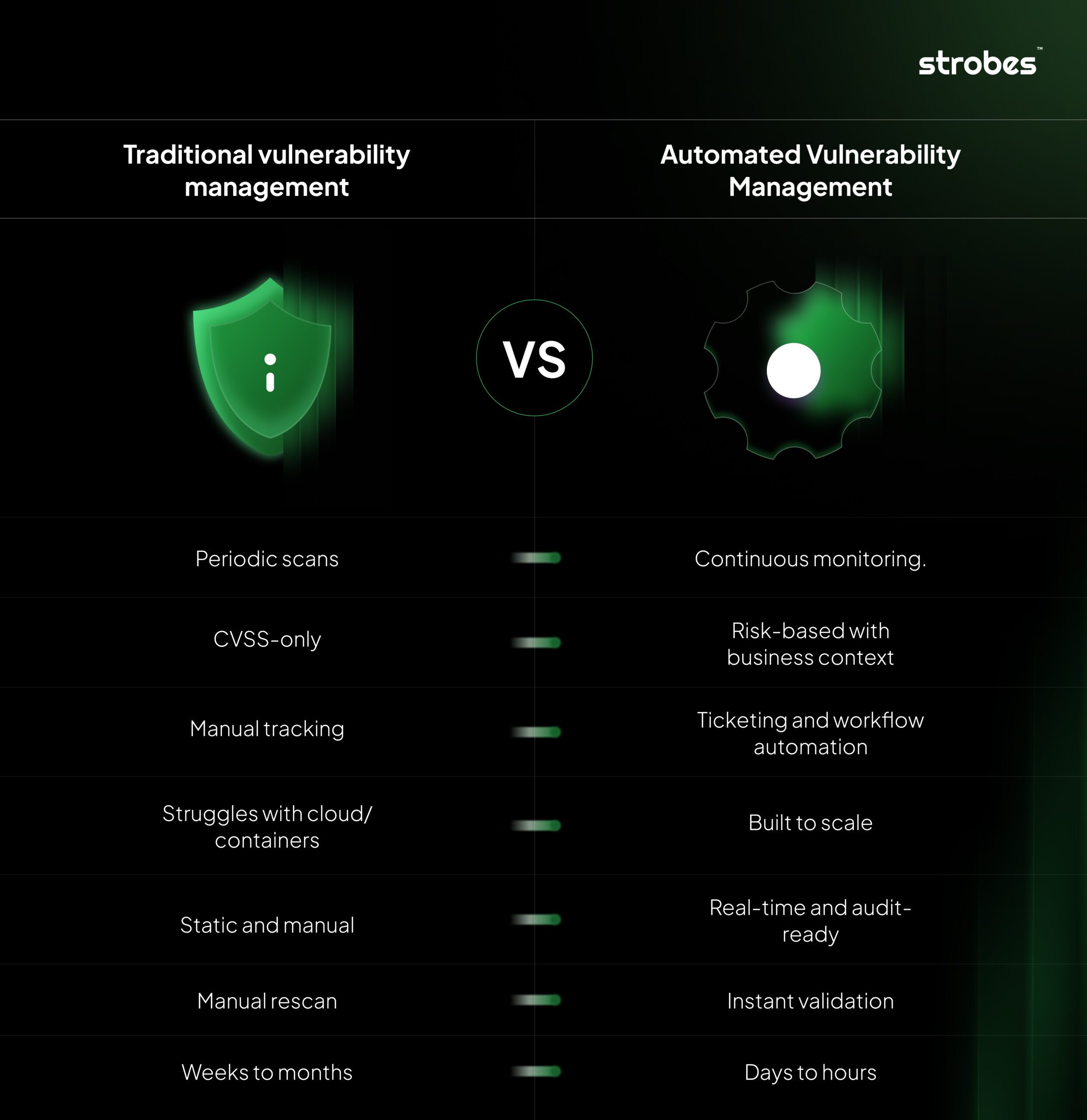
In the image below, we provided a detailed comparison between traditional vulnerability management and automated vulnerability management. This analysis will clarify the key differences, emphasizing the advantages of automation in enhancing security practices.
Benefits of Automated Vulnerability Management
The transition to automated vulnerability management brings quantifiable advantages in both security and business operations.
1. Speed and Efficiency
Time between discovery and remediation is lowered through automation. Rather than waiting days or weeks for manual triage, vulnerabilities can be discovered, prioritized, and allocated in minutes.
2. Scalability Across Hybrid Environments
Automated systems can manage large-scale environments across on-premise, multi-cloud, and SaaS applications to maintain consistent security coverage.
3. Improved Accuracy
Correlation and deduplication avoid false positives and duplicate alerts so teams can concentrate on actual threats.
4. Risk-Based Focus
Automated prioritization guarantees that vulnerabilities with exploited weaknesses or those impacting top-level business services are remediated first.
5. Integration with DevSecOps
By integrating vulnerability management with CI/CD pipelines, problems are identified sooner in the development cycle, lowering costs and remediation times.
6. Compliance Readiness
Automated evidence gathering makes regulatory audits easier. Reports can instantly be produced to demonstrate compliance with standards such as PCI-DSS, HIPAA, and ISO 27001.
Key Technical Capabilities to Seek in an Automated Vulnerability Management Solution
In choosing an automation platform for vulnerability management, organizations must pay attention to the following technical capabilities:
1. Continuous Asset Discovery
A strong automated Vulnerability Management solution must provide ongoing visibility into every asset connected to the environment. This includes managed and unmanaged devices, cloud workloads, APIs, and even shadow IT. Without this, gaps in coverage leave potential exposures unmonitored. Continuous discovery ensures new assets are automatically added to the inventory the moment they appear, creating a real-time, accurate picture of the attack surface.
2. Multi-Scanner Support
Supporting a range of scanners (SAST, DAST, SCA, container, and cloud misconfigurations) guarantees full coverage.
3. Exploit Intelligence Integration
A vulnerability’s severity score doesn’t always reflect its real-world impact. To prioritize effectively, solutions must integrate exploit intelligence. This means mapping CVEs against known exploits, public proof-of-concept code, or active campaigns. By correlating vulnerabilities with live threat intelligence, organizations can focus first on risks that attackers are actively targeting.
4. Workflow Automation
Finding vulnerabilities is only half the job; getting them fixed is the real challenge. A modern solution must automate this process by directly integrating with ITSM and DevOps tools like Jira, ServiceNow, or GitHub. When a critical vulnerability is detected, the system should automatically create and assign a ticket to the right team, complete with remediation details. This eliminates delays caused by manual communication and ensures accountability from discovery through resolution.
5. Role-Based Access Control (RBAC)
As vulnerability data can be sensitive, access must be carefully controlled. Role-Based Access Control ensures only the right people see the right information. For example, developers can access findings related to their applications, while security managers can view organization-wide metrics. This approach prevents data sprawl while maintaining transparency and accountability across teams.
6. API-First Architecture
Enterprises often operate with a complex web of tools—from SIEMs and SOAR platforms to CI/CD pipelines and cloud security solutions. An API-first architecture allows the automated VM solution to integrate seamlessly into this ecosystem. APIs enable smooth data exchange, custom automation, and scaling across thousands of assets without disrupting existing workflows.
Conclusion
Managing vulnerabilities manually is difficult. The alerts keep piling up, new flaws surface every week, and before you know it, critical risks slip through the cracks. Automation flips that script. It gives you a way to keep pace with the constant flow of issues, finding them faster, sorting the noise, and making sure the right ones get fixed first.
At Strobes Security, we take this a step further with our Risk-Based Vulnerability Management (RBVM) platform. Unlike traditional tools that only highlight vulnerabilities, Strobes RBVM adds business context, exploit intelligence, and automation to ensure your teams are always working on the vulnerabilities that actually matter. It reduces noise, shortens remediation timelines, and gives you a single, actionable view of your risk posture across cloud, applications, and infrastructure.
The end result? A smoother workflow, quicker remediation, and stronger security without the extra effort.
Book a demo with Strobes today and discover how automating vulnerability management can save your team time.


